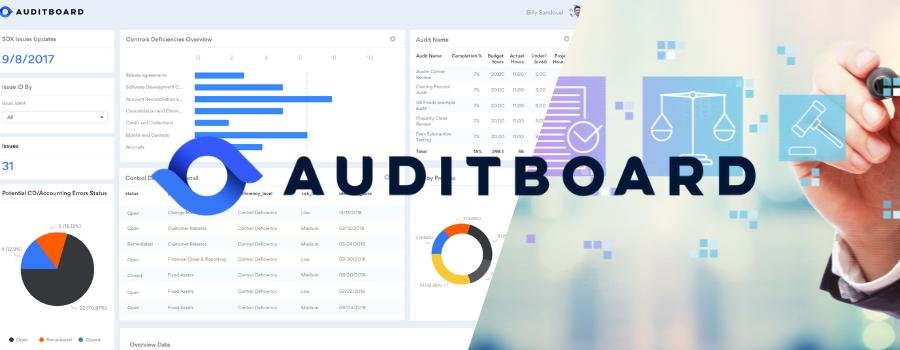AuditBoard aims to help organizations improve their audit, risk, and compliance management processes by providing a centralized and automated platform that enhances efficiency, transparency, and collaboration. This article discusses AuditBoard user reviews, features, benefits, limitations, and alternatives.
What is the AuditBoard?
AuditBoard is a cloud-based software platform that provides companies with tools and solutions for internal audit, risk management, and compliance management. It is designed to streamline and automate audit processes, risk assessments, and compliance management activities, enabling organizations to effectively manage their internal audit functions and ensure compliance with regulatory requirements.
The software offers many features and modules, including risk assessment, audit planning, audit management, issue tracking, compliance management, and reporting. The platform provides a collaborative environment for audit teams to plan, execute, and report on audit engagements, manage findings and track progress on remediation efforts. It also provides risk assessment and management tools, helping organizations identify and assess risks and develop risk mitigation strategies.
User Review of AuditBoard
AuditBoard receives mostly positive reviews from several user review sites. Users at Software Advice rate AuditBoard at 4.7 out of 5.0, and users at G2 rate them at 4.7 out of 5.0.
Melissa Cass, Director of Business Operations at MDA, said, “AuditBoard has exceeded my expectations on ease of use, being able to customize the exports that you need for reporting. The dashboards are fantastic and easy to configure, depending on the data that you need to present. The feedback from using the tool has been only positive.”
Feature of AuditBoard
The software offers a range of features and functionalities designed to streamline internal audit, risk management, and compliance management processes. Some of the key features of AuditBoard are given below:
Audit Planning and Management
The software provides tools for planning and managing internal audit engagements, including risk assessment, scoping, scheduling, and resource allocation. It allows audit teams to create audit programs, assign tasks, track progress, and generate reports, making managing and executing audit projects easier. It provides a collaborative environment for audit teams to work together on projects.
Risk Assessment and Management
The software offers features for identifying, assessing, and managing organizational risks. It provides a comprehensive risk assessment framework that allows organizations to define risk criteria, assess risks, and prioritize risks based on severity and likelihood. It also provides tools for developing risk mitigation strategies and monitoring risk mitigation activities.
Compliance Management
The software enables organizations to manage compliance requirements, including regulatory compliance, internal policies, and industry standards. It helps organizations track compliance tasks, manage documentation, and monitor compliance status. It also provides tools for conducting compliance audits and generating compliance reports. This integration helps streamline audit processes and improves data accuracy and consistency.
Issue Tracking and Remediation
AuditBoard allows organizations to track and manage audit findings and control deficiencies and other issues identified during internal audits. It provides features for assigning and tracking remediation tasks, setting due dates, and monitoring progress. It also allows for collaboration among audit teams and business units to ensure the timely resolution of audit findings.
Benefits of AuditBoard
There are several benefits of using AuditBoard for internal audit, risk management, and compliance management processes. Some of the key benefits are given below:
Enhanced Efficiency and Productivity
The software automates many manual and time-consuming audit, risk, and compliance tasks, such as audit planning, risk assessment, issue tracking, and reporting. It helps to streamline workflows, reduce administrative overhead, and increase the overall productivity of audit teams, allowing them to focus on higher value-added activities.
Improved Risk Management
AuditBoard provides a comprehensive risk assessment framework that enables organizations to identify, assess, and prioritize risks. It allows organizations to establish risk criteria, assess risks based on severity and likelihood, and develop risk mitigation strategies. It helps organizations to proactively manage risks and make informed decisions to mitigate risks effectively.
Enhanced Compliance Management
The software helps organizations manage compliance requirements by providing tools to track compliance tasks, manage compliance documentation, and monitor compliance status. It also facilitates compliance audits and generates compliance reports, helping organizations demonstrate compliance with regulatory requirements, internal policies, and industry standards.
Better Collaboration and Communication
AuditBoard provides a collaborative environment for audit teams to work together on audit projects, facilitating document sharing, task assignments, and real-time progress tracking. It also enables communication and collaboration among audit teams, business units, and stakeholders, enhancing coordination and communication for effective audit execution.
Limitations of AuditBoard
While the software offers many benefits for internal audit, risk management, and compliance management processes, it also has some limitations. Some of the limitations of AuditBoard are given below:
Learning Curve
Like any new software, a learning curve may be associated with implementing and using the software. Organizations may need to invest time and resources in training and onboarding their audit teams to effectively use the software, which could impact productivity during the initial implementation phase. AuditBoard, like any software, may require regular updates and patches to address bugs, security vulnerabilities, and other issues.
Customization Limitations
While AuditBoard provides a range of customizable features, some organizations may have unique or complex requirements that the software may not fully support. It may result in limitations in terms of customization and configuration, which may not fully align with the organization’s specific needs. Its functionalities rely on third-party data sources, such as regulatory content, industry standards, and other data.
Integration Challenges
Although the software offers integration capabilities with other systems, such as ERP and GRC platforms, there may be challenges in integrating with existing systems or data sources within an organization. Establishing seamless data exchange and information flow between AuditBoard and other systems may require additional effort and resources.
Scalability
While AuditBoard is designed to accommodate organizations of various sizes, there may be limitations in terms of scalability for very large organizations with complex audit, risk, and compliance requirements. Organizations with a significant or high frequency of audits may face challenges managing large volumes of data and workflows within AuditBoard.
Alternatives of AuditBoard
There are several alternatives to AuditBoard software that offer similar services and features. Evaluating each alternative based on your needs and requirements is important to determine the best solution for you.
Some popular alternative solutions to AuditBoard may include Precoro, Odoo, Route4Me, Inspectorio, WISE, ProcureWare, Transplace TMS, Fishbowl, Coupa, and Excalibur WMS.
Conclusion
AuditBoard is a cloud-based software solution that offers a range of features for internal audit, risk management, and compliance management processes. It’s recommended to consult the official website, review documentation, and contact support for the most up-to-date and accurate information on the software.
Organizations considering implementing AuditBoard should thoroughly evaluate its features, benefits, and limitations in the context of their specific needs and requirements.



